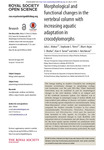Morphological and functional changes in the vertebral columnwith increasing aquatic adaptation in crocodylomorphs
| dc.contributor.author | Molnar, Julia L. | en_US |
| dc.contributor.author | Pierce, Stephanie E. | en_US |
| dc.contributor.author | Bhullar, Bhart-Anjan S. | en_US |
| dc.date.accessioned | 2016-10-11T05:37:07Z | |
| dc.date.available | 2016-10-11T05:37:07Z | |
| dc.date.issued | 2015 | en_US |
| dc.identifier.other | HPU4160641 | en_US |
| dc.identifier.uri | https://lib.hpu.edu.vn/handle/123456789/23529 | en_US |
| dc.description.abstract | The lineage leading to modern Crocodylia has undergone dramatic evolutionary changes in morphology, ecology and locomotion over the past 200+Myr. These functional innovations may be explained in part by morphological changes in the axial skeleton, which is an integral part of the vertebrate locomotor system. Our objective was to estimate changes in osteological range of motion (RoM) and intervertebral joint stiffness of thoracic and lumbar vertebrae with increasing aquatic adaptation in crocodylomorphs. | en_US |
| dc.format.extent | 22 p. | en_US |
| dc.format.mimetype | application/pdf | en_US |
| dc.language.iso | en | en_US |
| dc.subject | Biology | en_US |
| dc.subject | Palaeontology | en_US |
| dc.subject | Evolution | en_US |
| dc.subject | Biomechanics | en_US |
| dc.subject | Crocodylomorph | en_US |
| dc.subject | Vertebrae | en_US |
| dc.subject | Axial skeleton | en_US |
| dc.subject | Stiffness | en_US |
| dc.subject | Range of motion | en_US |
| dc.subject | Aquatic adaptation | en_US |
| dc.title | Morphological and functional changes in the vertebral columnwith increasing aquatic adaptation in crocodylomorphs | en_US |
| dc.type | Article | en_US |
| dc.size | 1.35MB | en_US |
| dc.department | Education | en_US |
Files in this item
This item appears in the following Collection(s)
-
Education [806]

